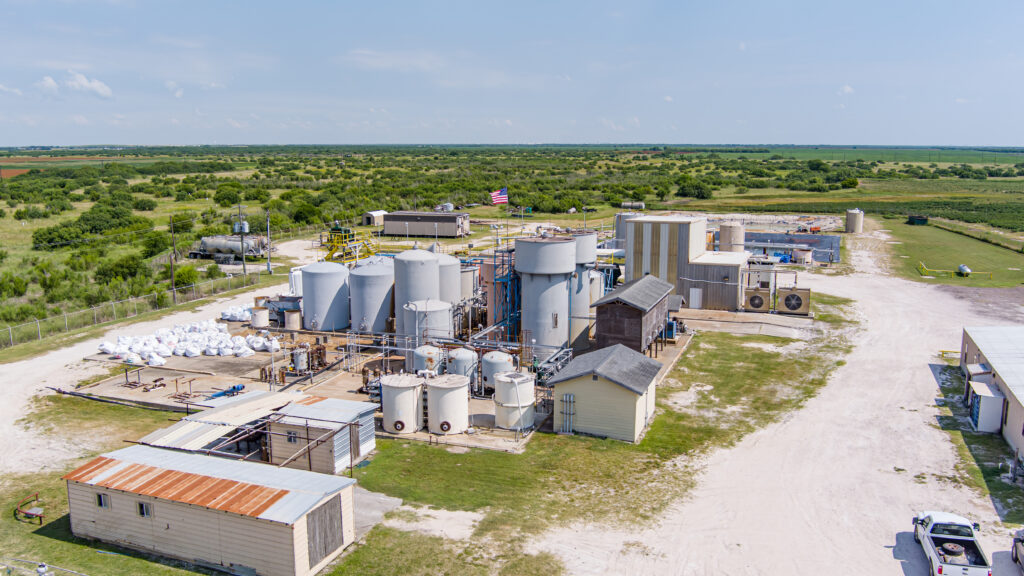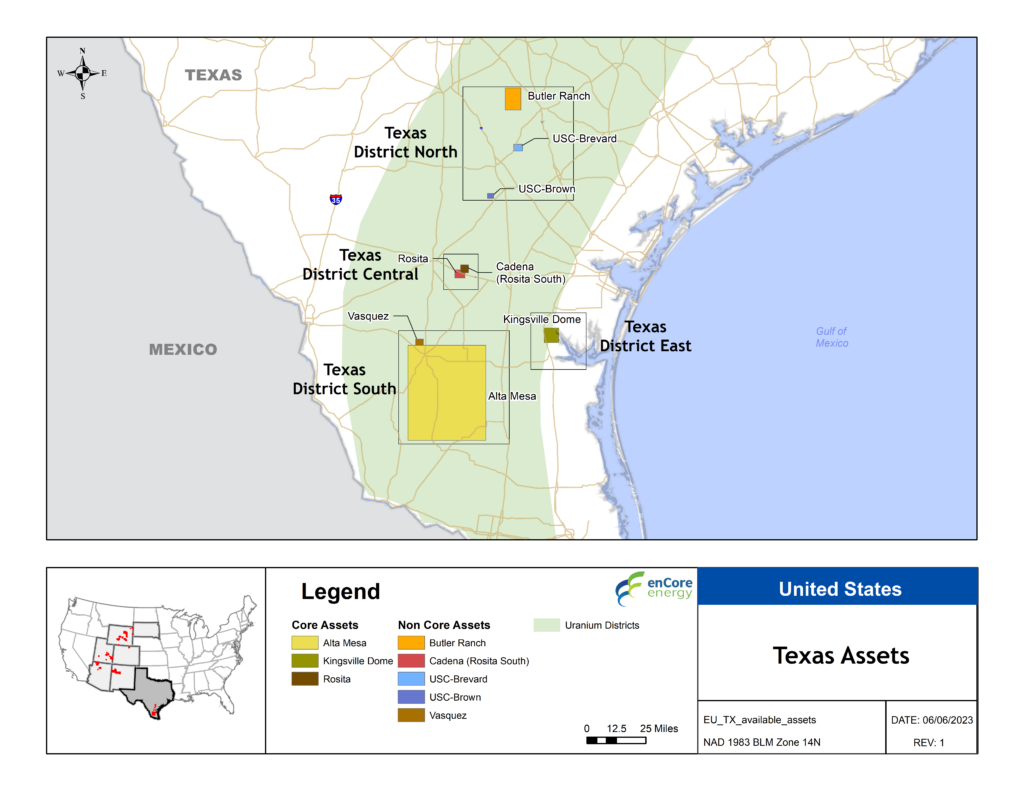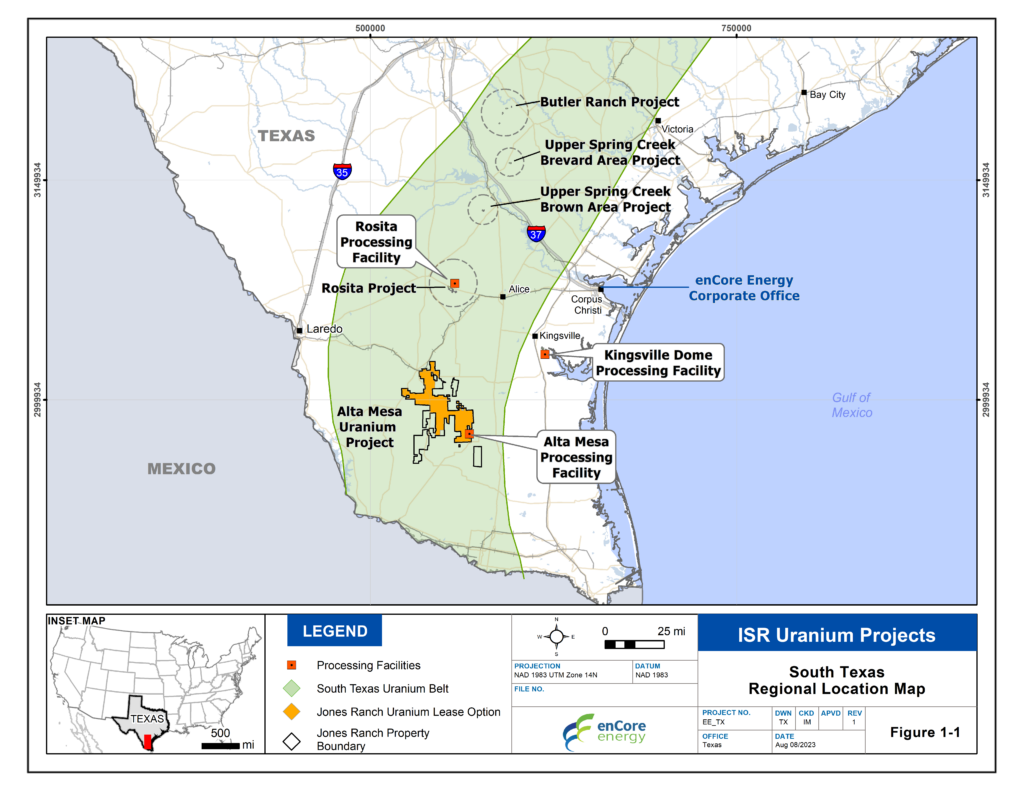South Texas ISR Uranium Central Processing Plants & Wellfields
Rosita, Alta Mesa, Kingsville Dome, and Other Texas Assets
South Texas Production Highlights

3 Fully-licensed, fully-constructed, and 100% enCore-owned production facilities

6 million pounds U3O8 per year combined capacity

Production targeted for 2023 with satellite feed to the Rosita ISR Uranium Central Processing Plant

Production expansion potential with minimal investment

enCore owns and controls 3 of the 4 licensed ISR uranium plants in Texas, a known and safe ISR uranium jurisdiction. There are currently 11 licensed ISR plants in the United States
About
enCore Energy owns and operates three of the four licensed uranium production facilities in Texas. Each of enCore’s facilities are fully licensed and constructed, 100%-owned, and are past-producing uranium production facilities in Texas, a known and safe ISR uranium jurisdiction. There are currently only 11 licensed ISR plants in the United States.
enCore Energy is focused on executing our production plan in South Texas starting at the Rosita ISR Uranium Central Processing Plant (CPP) and Wellfield in 2023, to be closely followed by the Alta Mesa ISR Uranium CPP and Wellfield in 2024. Both Central Processing Plants (CPPs) and Wellfields have licensed and permitted processing facilities and production areas. enCore’s operational plan is to produce uranium derived from multiple remote Satellite IX operations, in turn to be processed at one of our CPPs. enCore’s three CPPs are strategically located in north-central, central, and southern portions of south Texas.
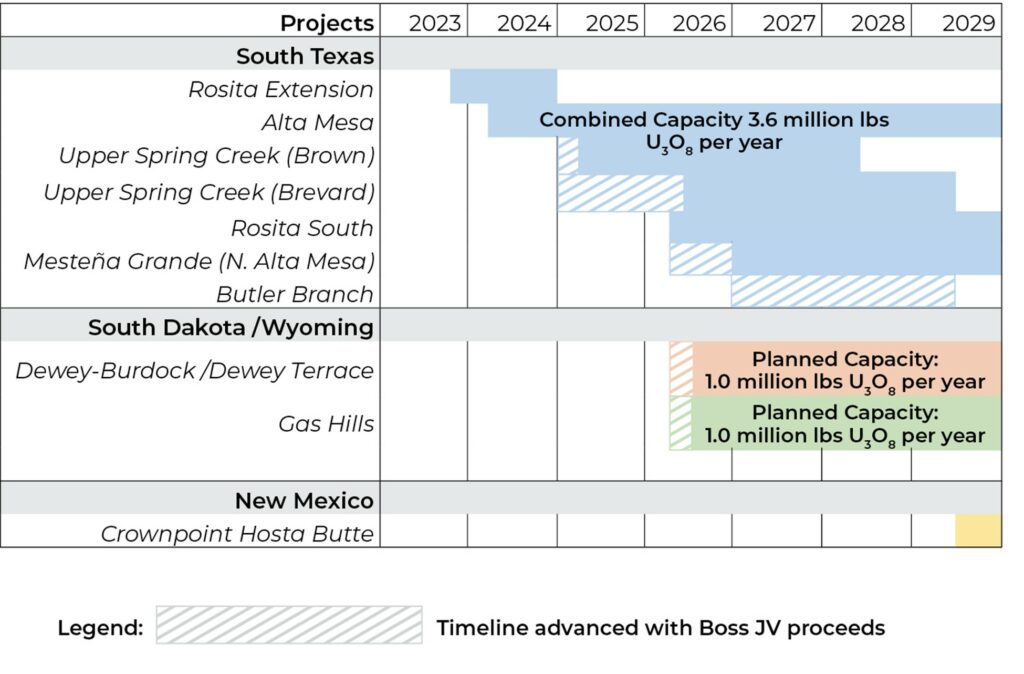
Central Processing Plants & Wellfields
Rosita ISR Uranium Central Processing Plant and Wellfield (Rosita), South Texas

Location
The Rosita CPP is located approximately 60 miles west of Corpus Christi, Texas in the Texas Uranium Belt and lies adjacent to, or nearby, to over 2,700 acres of mineral rights, including plant and wellfield facilities

Production
Licensed ISR production facility with a capacity of 800,000 pounds of U3O8 per year with past production of 2.65 million pounds of U3O8; anticipated start of production in 2023 from the Rosita Extension (PAA-5)

Status
The Rosita CPP refurbishment and upgrades were completed in 2022 and the plant has infrastructure in place to increase capacity substantially when needed
The Rosita ISR Uranium Central Processing Plant (CPP) and Wellfield is enCore’s initial focus for production in November 2023. The Rosita CPP is located on a 270-acre surface tract, 100% owned by enCore, located central to the mining lease area. The Rosita CPP will receive uranium-loaded resins from various remote south Texas projects and satellite wellfields.
Initial production of uranium from the Rosita CPP, commenced in 1990 and continued until July 1999. During that time, 2.65 million pounds of U3O8 were produced. It was originally designed and constructed to operate as an up-flow ion exchange facility, in a similar manner to the Kingsville Dome CPP. Resin was processed at the Rosita CPP, and the recovered uranium was precipitated into slurry, which was then transported to Kingsville Dome for final drying and packaging. Production was halted in July of 1999 due to depressed uranium prices, and it resumed in June 2008. Technical difficulties, coupled with a sharp decline in uranium prices, led to the decision to suspend production activities in October 2008. No production has occurred at the Rosita CPP and Wellfield since that time.
During 2007-2008, upgrades were made to the processing equipment and additions to the facility were installed, including revisions to the elution and precipitation circuits, and the addition of a full drying system. Construction terminated when the plant was 95% complete due to production and price declines. The current plant is designed to have an operating capacity of 800,000 pounds of U3O8 per year when production commences. One satellite ion exchange system is in place at the Rosita Wellfield, but it only operated for a short period of time in 2008. A second satellite ion exchange system will be constructed to accommodate expected production from the wellfield that is currently under construction. On November 1, 2022, the Company announced that it had completed the refurbishment of the Rosita CPP, a key step toward the goal of the Company becoming the next producer of American uranium. In April 2023, the wellfield for Rosita Extension was completed, and the installation of the surface and electrical infrastructure commenced. The construction of the 1,000 GPM satellite IX system to service the Rosita Extension wellfield commenced in May 2023. The construction of the surface infrastructure, including pipelines, oxygen supply, manifolds, metering, and electrical connections continued through the third quarter.
Rosita Wellfield
The Rosita Project is comprised of four Texas Commission on Environmental Quality (TCEQ) authorized production area authorizations (PAA). Production areas 3 and 5 contain limited uranium resources. The company completed the final phase of TCEQ required stabilization in production areas 1 and 2. The Company began plugging wells in production areas 1 and 2 in 2014 and completed those activities in 2016. Completion of the surface reclamation in production areas 1 and 2 was temporarily halted in 2019 and resumed in early 2020 with completion anticipated in 2023, pending acceptance by the TCEQ. The Company received approval of production area 5, authorizing injection in the Rosita Project Extension wellfield in September.
In November 2023, the Company received approval from TCEQ for the renewal of its radioactive material license for the Rosita Project. The underground injection control permit, issued on October 14, 2014, remains in good standing. Production could resume in areas already included in existing production area authorizations. As new areas are proposed for production, additional authorizations from TCEQ under the permit will be required. The waste disposal well permit has been renewed.
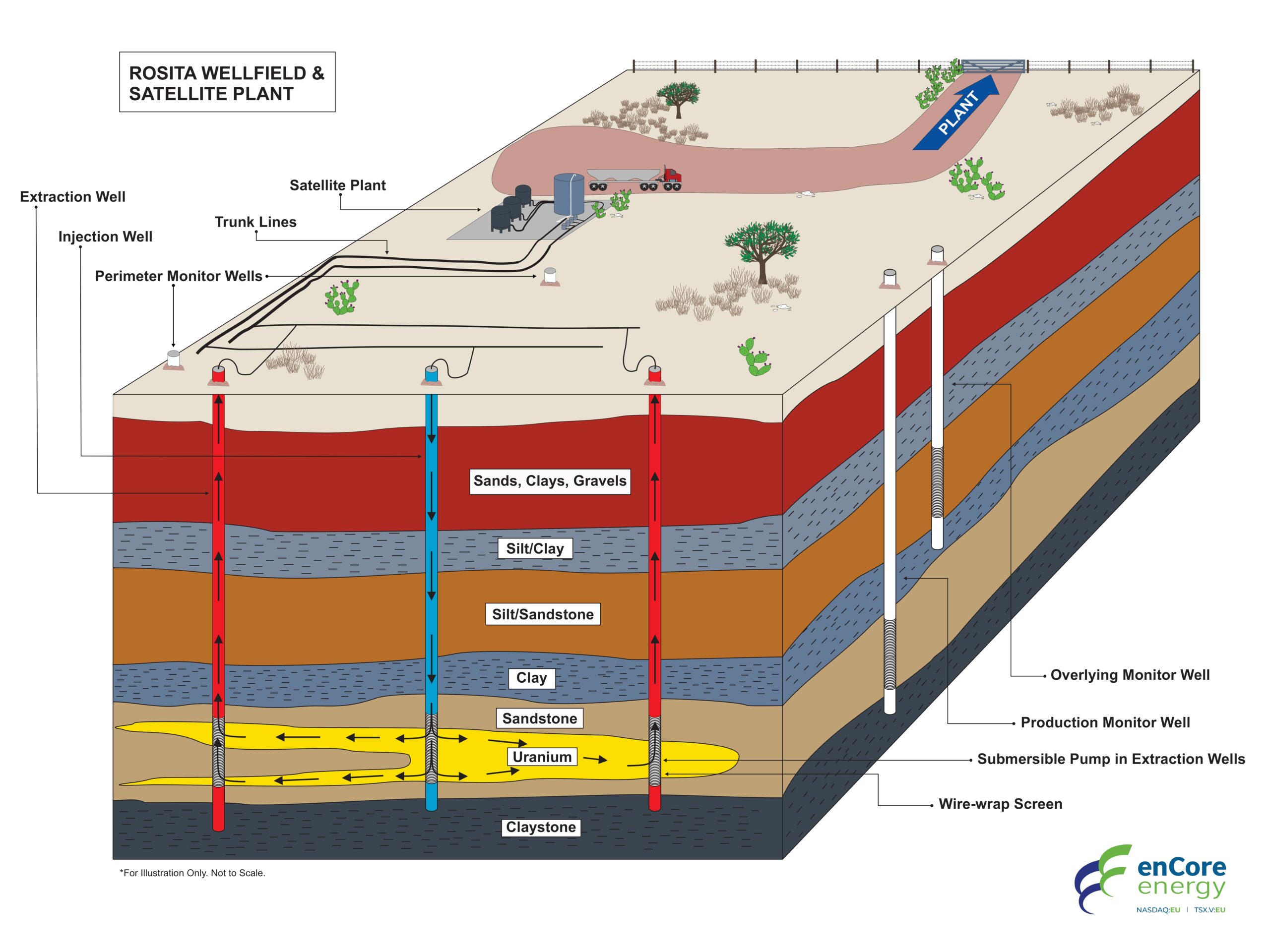
Satellite Operation for the Rosita CPP and Wellfield
Rosita Project Extension, Duval County, Texas – The Company has advanced wellfield development within the Rosita Project radioactive materials license and injection permit boundaries. The mineral resources in this area were never produced and present a rapid opportunity for early production. The Company is completing installation of production patterns in the production area and has been followed quickly by the installation of the necessary infrastructure to operate with a satellite ion exchange system. Production will commence in November 2023.
Rosita South, Duval County, Texas – enCore announced positive results from its on-going uranium delineation and exploration drill programs at its 100% owned Rosita South Wellfield. The Wellfield is adjacent to the Rosita CPP. The Rosita South Wellfield area provides one of the most optimal sources of satellite feed for the Rosita CPP. Thirty-two drill holes were reported for a total of approximately 11,000 feet including 20 delineation drill holes and 12 exploration drill holes. The exploration drilling has identified 8 mineralized sands plus an additional 4 potentially mineralized sands, all within 800 feet of the surface, which provide opportunities for discovery of future uranium resources across the entire Rosita Wellfield. Delineation drill results established an extension of mineralization in the future Production Area which supports the start-up of production. Further work on this project area has been deferred as drilling commenced on the Rosita Extension and the Company’s Alta Mesa Uranium Project. Further evaluation of historic and current data is in progress to prioritize prospective resource areas within the project area.
Butler Ranch Wellfield, Karnes Couty, Texas – enCore acquired the Butler Ranch Wellfield from Rio Grande Resources in 2014, as part of a larger property exchange. The property is comprised of non-contiguous fee leases that cover an area of about 438 acres of mineral rights. The Wellfield is in the southwestern end of Karnes County, Texas, about 45 miles southeast of the city of San Antonio, and 12 miles northwest of the town of Kenedy. The Wellfield is situated in the southwestern end of the Karnes County uranium mining district, which was one of the largest uranium production areas in Texas.
Uranium mineralization at Butler Ranch occurs in the form of roll-front deposits hosted primarily in sandstones of the Jackson Group, including the Deweesville and Stones Switch sandstone members of the Whitsett Formation. Some mineralization in the area also occurs as tabular bodies associated with lignite (carbonaceous material) or in somewhat permeable units in the Conquista Clay.
Butler Ranch Project, Karnes County, Texas – The Company acquired the Butler Ranch Project from Rio Grande Resources in 2014, as part of a larger property exchange. The property is comprised of non-contiguous fee leases that cover an area of about 438 acres of mineral rights. The Project is in the southwestern end of Karnes County, Texas, about 45 miles southeast of the city of San Antonio, and 12 miles northwest of the town of Kenedy. The Project is situated in the southwestern end of the Karnes County uranium mining district, which was one of the largest uranium production areas in Texas.
Upper Spring Creek Project, Live Oak and Bee Counties, Texas -The Company acquired several mineral properties located in South Texas, within the area generally described as the Upper Spring Creek Project (USC) area. The Project is currently comprised of two distinct areas: USC-Brown Area (Live Oak County) and USC Brevard Area (Live Oak and Bee Counties). The USC-Brown Area Project is currently comprised of both Company-owned properties and both non-contiguous and contiguous fee leases that cover an area of approximately 510 acres of surface and mineral rights, and the Company is actively acquiring additional mineral properties for this Project. The USC Brevard Area is currently comprised of a single lease of approximately 274 acres of surface and mineral rights. As with USC Brown Area, the Company is actively acquiring additional mineral properties for this Project. These properties are intended to be developed as satellite ion-exchange plants that will provide loaded resin to the Rosita CPP.
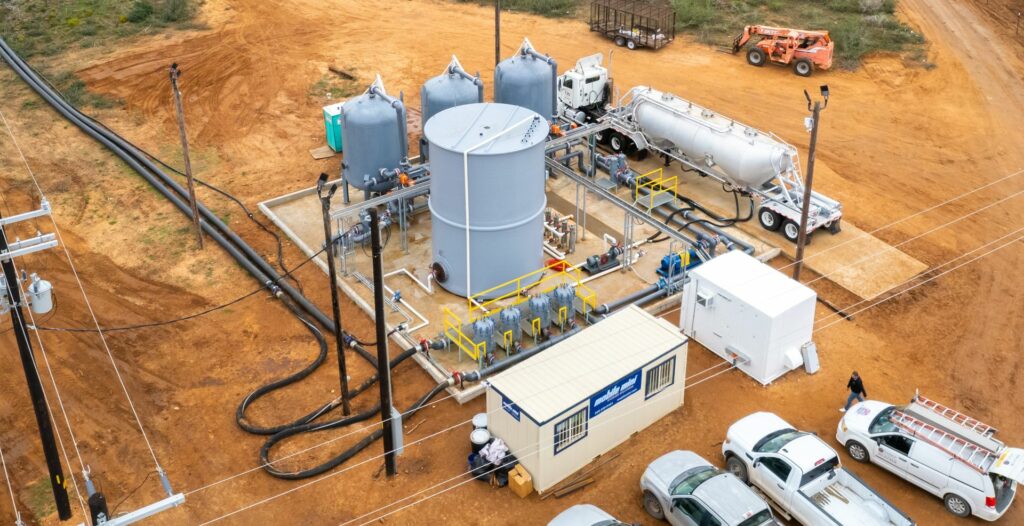
The Company advises that it is not basing its production decisions at Alta Mesa CPP or Rosita CPP on a feasibility study of mineral reserves demonstrating economic and technical viability. The production decision is based on known past In-Situ Recovery (ISR) and processing operations at these two production facilities and surrounding lands. However, the Company understands that there is increased uncertainty, and consequently a higher risk of failure, when production is undertaken in advance of a feasibility study. The Company has determined to proceed with a production decision based on past operations at the Alta Mesa CPP and Rosita CPP, including past ISR operations in the known mineral resource areas.
Alta Mesa ISR Uranium Central Processing Plant and Wellfield

Location
Located 80 miles from the Rosita CPP and 75 miles from the Kingsville Dome CPP

Production
Total operating capacity of 1.5 million pounds of uranium/year with planned production starting in 2024

Status
Fully licensed past-producing plant with existing resources
The Alta Mesa ISR Uranium Central Processing Plant (CPP) is located on a 45-acre surface tract, subject to a 70/30 joint venture between enCore Energy and Boss Energy Ltd., within the existing mining lease area. The joint venture is managed by enCore Energy. The CPP was expanded in 2008 to allow it to operate at 7,500 gallons per minute and recover ion exchange resin at a rate of 1.5 million pounds U3O8 per year. The yellowcake drying and packaging system was increased to 2 million pounds U3O8 per year. The CPP is connected directly to the production areas through pipelines due to the proximity of the nearby uranium ore bodies. For more distant uranium ore bodies, the CPP can be modified to accept loaded resins transported from satellite IX systems in a manner similar to the planned operations at our 100% owned Rosita Wellfield.
Alta Mesa and Mesteña Grande Wellfields
- The Alta Mesa and Mesteña Grande Wellfield areas include uranium mineral-bearing sandstones of the Goliad, Oakville, and Catahoula Formations- contained within approximately 52 linear miles of stacked geochemical REDOX and mineralized fronts. Only 5 miles of mineralized trends have been closely drilled out to date. The Alta Mesa Wellfield is located in Brooks County while the majority of the Mesteña Grande Wellfields are located in Jim Hogg County, Texas.
- The Alta Mesa Wellfield is an established ISR uranium project and a past uranium producer. The Alta Mesa properties are comprised of the Alta Mesa mine area and processing facility, the South Alta Mesa (SAM) and Indigo Snake exploration areas located in Brooks County. The Mesteña Grande Wellfield, is comprised of multiple prospective areas known as Mesteña Grande Goliad (MGG) Mesteña Grande North (MGN), Mesteña Grande Central (MG), Mesteña Grande Alta Vista (AV), and El Sordo East (ESE) and West (ESW). The Alta Mesa CPP and mine office are located at the Alta Mesa property approximately 11 miles west of the intersection of US 281 and Ranch Road 755, which is also 22 miles south of the town of Falfurrias.
- The Alta Mesa and Mesteña Grande Wellfields consists of uranium mining and exploration leases for uranium ISR production (4,598 acres) and Mineral Options (195,501 acres). The Wellfields comprise a total of 200,099 acres with currently approved mining permits issued by the Texas Commission on Environmental Quality (“TCEQ”) and exploration permits approved by the Railroad Commission of Texas covering the mine area and 9 nine large prospect areas. The Alta Mesa Wellfield is located within a portion of the private land holdings of the Jones Ranch, founded in 1897, and includes surface and mineral rights as well as oil and gas and other minerals including uranium. Active uses of the lands in addition to uranium exploration and production activities include agricultural use (cattle), oil and gas development, and private hunting. Previous owners include Chevron Minerals, Total Minerals, Cogema Mining, Uranium Resources Inc., Mesteña Uranium LLC (MULLC), formed by landowners, and Energy Fuels Inc. In 2016, Energy Fuels, Inc. acquired the Wellfield from MULLC. In November 2022, enCore and a subsidiary of Energy Fuels Inc. executed a Membership Interest Purchase Agreement whereby enCore agreed to acquire four limited liability companies that together hold 100% of the Wellfield. Please see the enCore Energy Corp. press release dated November 14, 2022, for additional details on the transaction.
- The Wellfield produced approximately 4.6 million pounds of uranium oxide between 2005 and 2013 via in-situ recovery using an alkaline lixiviant processed at the Alta Mesa CPP. The facility was in production from 2005 until primary production ceased February 2013. The Wellfield operated in a groundwater clean-up mode until February 2015; therefore, any uranium mined since 2013 remains as in-circuit inventory.
- The first wellfield (PAA-1) has completed final groundwater restoration and was approved by the Texas Commission on Environmental Quality in March 2018. All other wellfields are being maintained by a small bleed (less than 100 gpm) for permit compliance. The bleed solutions are disposed of in deep disposal wells.
- A radioactive material license issued by the TCEQ for the Alta Mesa Wellfield is in timely renewal. The underground injection control permit is in timely renewal and remains in good standing. Production could resume in areas already included in existing production area authorizations, and Production Area Authorization 7 (PAA-7) is fully authorized and currently undergoing the installation of new production patterns. The Wellfield has two waste disposal wells that have had their permits recently renewed.
Alta Mesa and Mesteña Grande – | ||||
| Resource Category | Tons (‘000) | Grade (%U3O8) | Contained U3O8 (‘000 lbs) | |
| Within existing wellfields | Measured | 54 | 0.152 | 164 |
| Alta Mesa | Indicated | 1,397 | 0.106 | 2,959 |
| Mesteña Grande | Indicated | 119 | 0.120 | 287 |
| Total M&I Mineral Resources | 1,570 | 0.109 | 3,410 | |
| Alta Mesa | Inferred | 1,263 | 0.126 | 3,192 |
| Mesteña Grande | Inferred | 5,733 | 0.119 | 13,601 |
| Total Inferred Mineral Resource | 6,996 | 0.120 | 16,793 | |
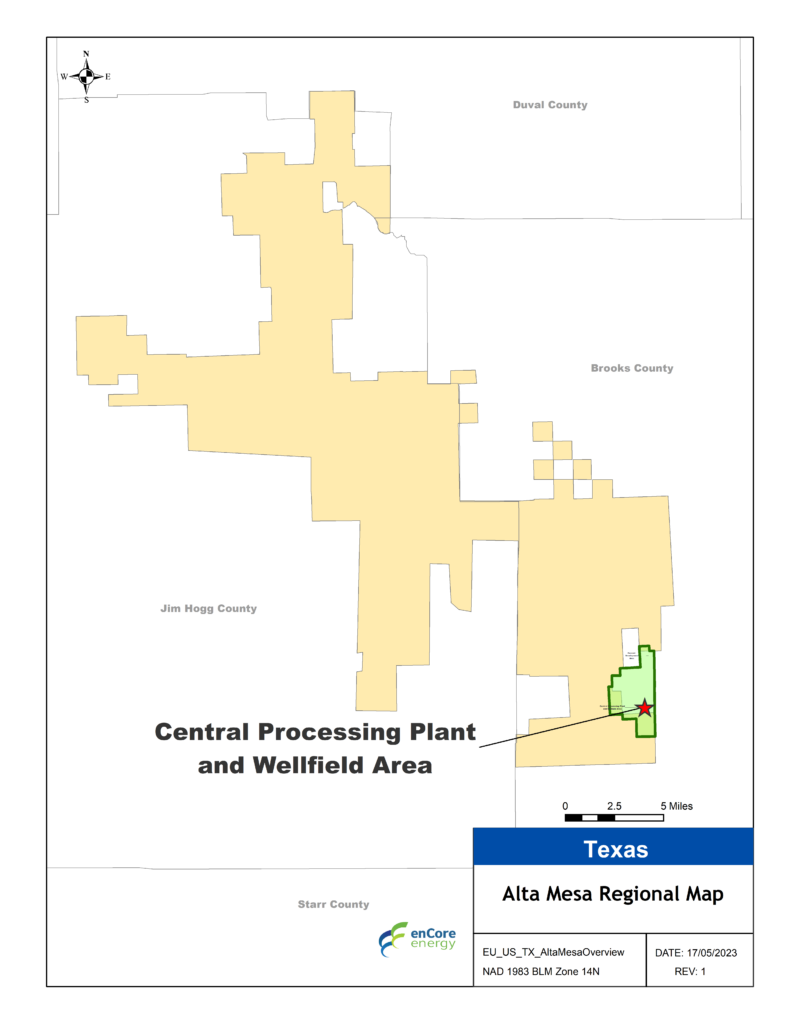
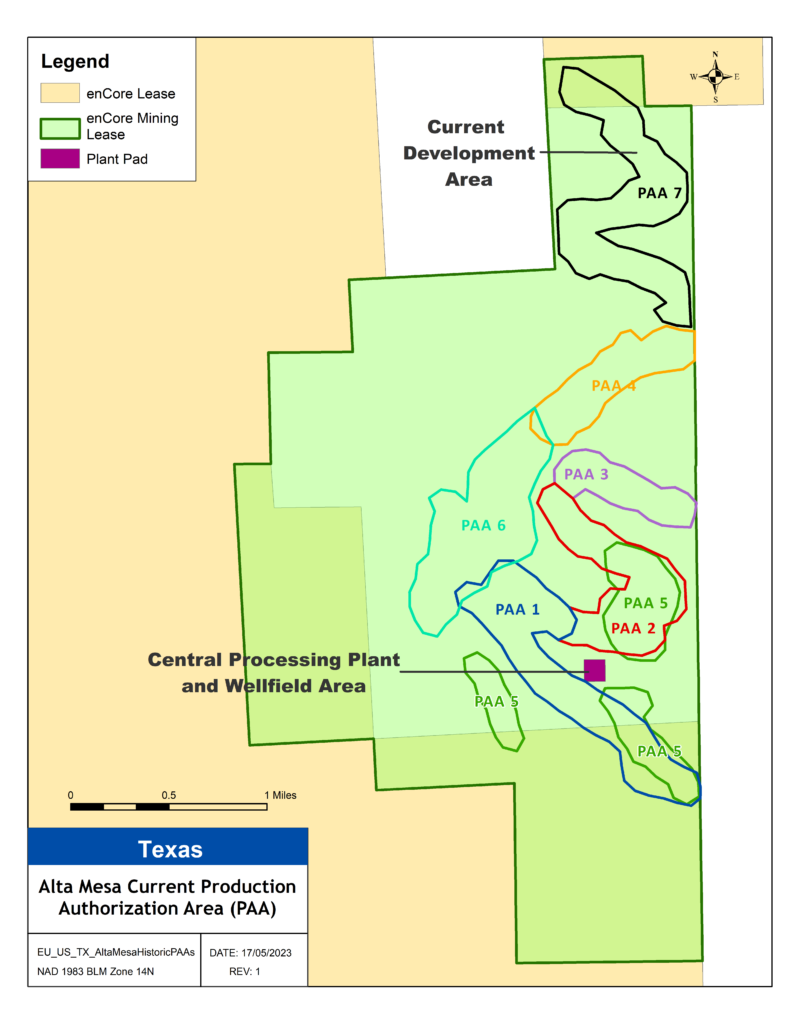
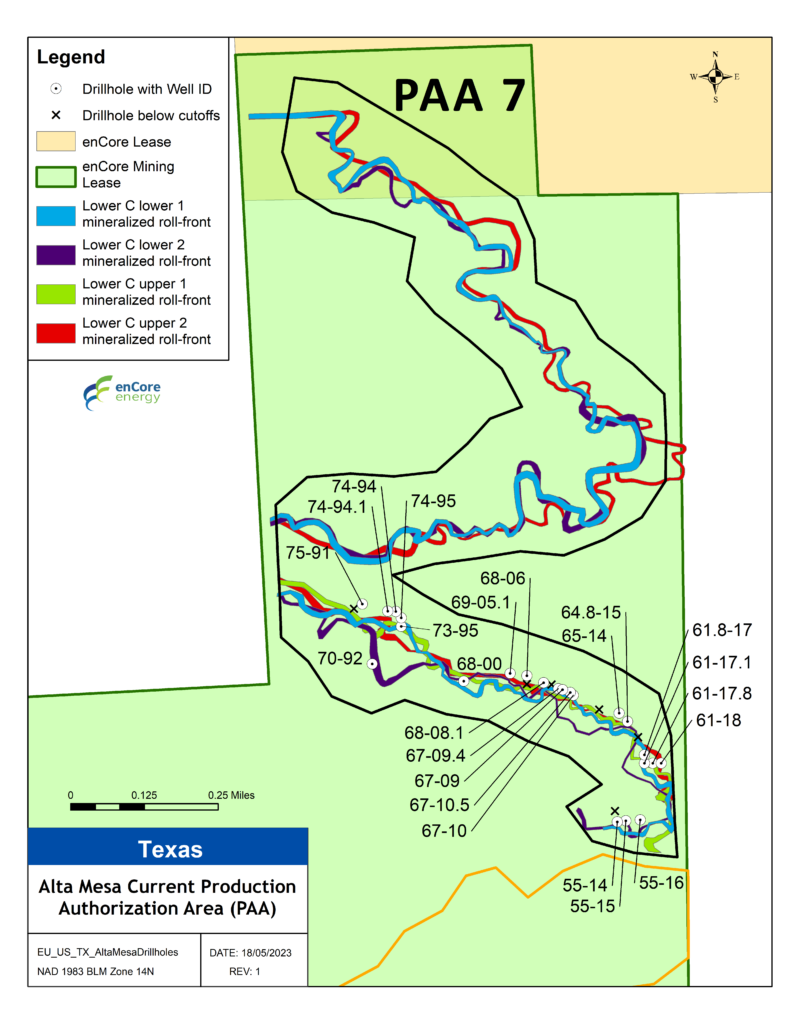
The Company advises that it is not basing its production decisions at Alta Mesa CPP or Rosita CPP on a feasibility study of mineral reserves demonstrating economic and technical viability. The production decision is based on known past In-Situ Recovery (ISR) and processing operations at these two production facilities and surrounding lands. However, the Company understands that there is increased uncertainty, and consequently a higher risk of failure, when production is undertaken in advance of a feasibility study. The Company has determined to proceed with a production decision based on past operations at the Alta Mesa CPP and Rosita CPP, including past ISR operations in the known mineral resource areas.
Kingsville Dome ISR Uranium Central Processing Plant and Wellfield

Location
40 miles southwest of the city of Corpus Christi in Kleberg County, Texas

Production
Production capacity of 800,000 pounds of U3O8 per year

Status
Uranium production at Kingsville Dome was suspended in 2009 and the CPP has been in a standby status since that time.
The Kingsville Dome ISR Uranium Central Processing Plant (CPP) and Wellfield is comprised of multiple tracts of land leased from third parties. The Kingsville Dome CPP is situated on approximately 15 acres of Company-owned land, surrounded by leased acreage located approximately eight miles southeast of the city of Kingsville. The CPP & Wellfield was constructed in 1987 as an up-flow uranium ion exchange circuit, with complete drying and packaging facilities within the recovery plant. The CPP & Wellfield produced uranium between 1988 and 1990, from 1996 to 1999, and most recently from 2007 through 2009. Two independent resin processing circuits and elution systems comprise the plant’s processing equipment, along with a single drying circuit.
The CPP has two 500 gallon per minute reverse osmosis systems for groundwater restoration. The first unit was idled in 2010 and the second unit was idled in January of 2014, when groundwater restoration was completed. The CPP can serve as a processing facility that can accept resin from multiple satellite facilities. In addition to the CPP, there are four satellite ion exchange systems in the wellfield area. Each of the satellite systems is capable of processing approximately 900 gallons per minute of uranium-bearing ISR fluids from well fields, and these satellite plants can be relocated to alternate extraction sites as needed.
Satellite Operations for the Kingsville Dome CPP and Wellfield
Vasquez Wellfield, Texas – The Vasquez Wellfield is located in southern Duval County, Texas, a short distance northwest of the town of Hebbronville. The project operated from 2004 through 2008 as a satellite plant operation to the Kingsville Dome CPP until the mineral resource was depleted and reclamation commenced. The Wellfield is situated on a leased tract of land that is being held until final restoration has been completed. The Vasquez property consists of a mineral lease of 1,023 gross and net acres. While the primary term of the mineral lease expired in February 2008, the Company continues to hold the lease by carrying out restoration activities.
